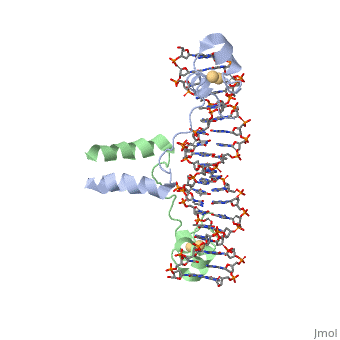User:Ann Taylor/Sandbox 1
From Proteopedia
(Difference between revisions)
| Line 1: | Line 1: | ||
| - | [[Image:3d06.jpg|left|200px]] | ||
| - | <!-- | ||
| - | The line below this paragraph, containing "STRUCTURE_3d06", creates the "Structure Box" on the page. | ||
| - | You may change the PDB parameter (which sets the PDB file loaded into the applet) | ||
| - | or the SCENE parameter (which sets the initial scene displayed when the page is loaded), | ||
| - | or leave the SCENE parameter empty for the default display. | ||
--> | --> | ||
| - | {{ | + | {{STRUCTURE_1d66| PDB=1d66 | SCENE= }} |
| - | === | + | ===Evaluating scenes representing the same structure=== |
| + | This sandbox compiles several student-generated scenes that illustrate properties of the Gal4 repressor. | ||
| - | + | ==Dimer== | |
| - | + | The protein binds as a <scene name='92/925538/Dimer/2'>dimer</scene> to a symmetrical 17-base-pair sequence. | |
| - | From MEDLINE®/PubMed®, a database of the U.S. National Library of Medicine. | ||
| - | ==Disease== | ||
| - | Known disease associated with this structure: Adrenal cortical carcinoma OMIM:[[http://www.ncbi.nlm.nih.gov/entrez/dispomim.cgi?id=191170 191170]], Breast cancer OMIM:[[http://www.ncbi.nlm.nih.gov/entrez/dispomim.cgi?id=191170 191170]], Colorectal cancer OMIM:[[http://www.ncbi.nlm.nih.gov/entrez/dispomim.cgi?id=191170 191170]], Hepatocellular carcinoma OMIM:[[http://www.ncbi.nlm.nih.gov/entrez/dispomim.cgi?id=191170 191170]], Histiocytoma OMIM:[[http://www.ncbi.nlm.nih.gov/entrez/dispomim.cgi?id=191170 191170]], Li-Fraumeni syndrome OMIM:[[http://www.ncbi.nlm.nih.gov/entrez/dispomim.cgi?id=191170 191170]], Multiple malignancy syndrome OMIM:[[http://www.ncbi.nlm.nih.gov/entrez/dispomim.cgi?id=191170 191170]], Nasopharyngeal carcinoma OMIM:[[http://www.ncbi.nlm.nih.gov/entrez/dispomim.cgi?id=191170 191170]], Osteosarcoma OMIM:[[http://www.ncbi.nlm.nih.gov/entrez/dispomim.cgi?id=191170 191170]], Pancreatic cancer OMIM:[[http://www.ncbi.nlm.nih.gov/entrez/dispomim.cgi?id=191170 191170]], Thyroid carcinoma OMIM:[[http://www.ncbi.nlm.nih.gov/entrez/dispomim.cgi?id=191170 191170]] | ||
| - | == | + | ==Domains== |
| - | + | There is a compact <scene name='92/925538/Metal_binding_domain/5'>metal binding domain</scene> (residues 8-40), an <scene name='92/925538/Extended_linker/4'>extended linker</scene> (41-49), and an <scene name='92/925538/Alpha-helical_dimerization/2'>alpha-helical dimerization element</scene> (50-64). | |
| - | == | + | |
| - | < | + | |
| - | + | ||
| - | + | ==Metal binding== | |
| - | + | A small, Zn(2+)-containing domain recognizes a conserved CCG triplet at each end of the site through direct contacts with the major groove. The metal binding domain contains <scene name='92/925538/Cysteine_metal_binding/3'>cysteine residues</scene> that coordinate to the metal as shown as cadmium. | |
| - | + | ||
| - | + | ||
| - | + | ||
| - | + | ==DNA/protein interaction== | |
| - | + | <scene name='92/925538/Dna_protein_interaction/3'>The DNA-Protein Interaction</scene> with all of the base pairs within 5 angstroms of the protein highlighted illustrates that the protein interacts with both strands of the UAS. | |
| - | + | ||
| - | + | ||
| - | + | ||
| - | + | ||
| - | + | ||
| - | + | ||
| - | + | ||
| - | + | ||
| - | + | ||
| - | + | ||
| - | + | ||
| - | + | ||
| - | + | ||
| - | + | ||
| - | + | ||
| - | + | ||
| - | + | ||
| - | + | ||
| - | + | ||
| - | + | ||
| - | + | ||
| - | + | ||
| - | + | ||
| - | + | ||
Revision as of 02:31, 22 September 2022
-->
| |||||||||
| 1d66, resolution 2.70Å () | |||||||||
|---|---|---|---|---|---|---|---|---|---|
| Ligands: | |||||||||
| |||||||||
| |||||||||
| Resources: | FirstGlance, OCA, RCSB, PDBsum | ||||||||
| Coordinates: | save as pdb, mmCIF, xml | ||||||||
Contents |
Evaluating scenes representing the same structure
This sandbox compiles several student-generated scenes that illustrate properties of the Gal4 repressor.
Dimer
The protein binds as a to a symmetrical 17-base-pair sequence.
Domains
There is a compact (residues 8-40), an (41-49), and an (50-64).
Metal binding
A small, Zn(2+)-containing domain recognizes a conserved CCG triplet at each end of the site through direct contacts with the major groove. The metal binding domain contains that coordinate to the metal as shown as cadmium.
DNA/protein interaction
with all of the base pairs within 5 angstroms of the protein highlighted illustrates that the protein interacts with both strands of the UAS.


